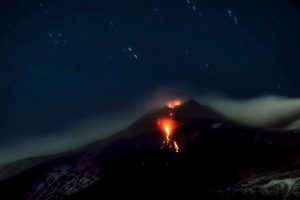
Scientists made a surprising discovery on their mission to find better indicators for impending volcanic eruptions: it looks like tree rings may be able to predict eruptions, report the Swiss Federal Institute for Forest, Snow and Landscape Research WSL and the ETH Zurich.
Nicolas Houlié, a geophysicist at ETH Zurich, first came to know about this potential early warning system in 2001. While looking at a satellite image, he noticed a three kilometres long green line on the north-east flank of Mount Etna. The line reflects the Normalised Difference Vegetation Index (NDVI): the higher the value, the more vegetation is thriving in the area. But what made the discovery really astonishing is the fact that the volcano erupted along that exact line just one year later.
Volcanologists and dendrochronologists join forces
Dendrochronologists agree that NDVI values are connected to tree growth, and thus reflected in tree-ring width. With that in mind, geographer Ruedi Seiler, a PhD student at WSL, and dendrologist Paolo Cherubini, Head of Dendrochronology at WSL, teamed up with Nicolas Houlié four years ago to embark upon a cross-disciplinary research project funded by the Swiss National Science Foundation. Their unusual idea — namely that tree rings give information about volcanic processes prior to eruptions — has now been published in the journal Scientific Reports.
The rings formed in tree trunks during trees’ growth periods are valuable repositories of environmental information: the ring width reflects the tree’s growth conditions, which are a combination of the temperature, precipitation and nutrient conditions during a given growing season. “The ring width may also be influenced by volcanic activity on Mount Etna and in other volcanic regions,” speculates Seiler.
Short pre-eruptive phase?
Under Cherubini’s direction, the researchers conducted their initial fieldwork alongside the lava flows that ran down Mount Etna’s west flank in January 1974. This was the location where Italian researchers also spotted an anomaly on satellite images in 1973, prior to the eruption.
Seiler took over fifty tree samples in the aim of identifying any pre-eruptive signals in the tree rings. However, the researchers found that the tree rings for summer 1973 were neither exceptionally wide nor exceptionally narrow.
“If volcanic activity does influence tree rings, then the pre-eruptive phase of the 1974 eruption can only have begun when the trees had already ceased their seasonal growth,” concludes Seiler. That said, the calculated duration of the pre-eruptive phase — which would be just a few months in this case — is actually consistent with the results of earlier geochemical and geophysical studies.
Restricted growth following an eruption
Although there were no changes to the trees’ growth before the 1974 eruption, the researchers’ article in Scientific Reports points out that the trees grew less in the two summers following the eruption than in other years. “I see great potential in this observation: we may be able to use tree rings to reliably date minor flank eruptions,” says volcanologist Houlié. This is significant because a volcano’s past behaviour can provide information about its future activities and thus contribute to improving measures to protect the population.
Thanks to real-time monitoring with GPS, seismometers and gas monitoring devices, the eruptions of the last twenty years are well documented. By contrast, volcanic eruptions occurring in the 2,000 years before that cannot be dated reliably, while the dates of even older volcanic events can be determined relatively accurately using the C14 method. Houlié is optimistic: “Tree ring data could help to close the information gap for the period stretching from 20 to 2,000 years ago.” In any case, the researchers want to continue their investigations into whether tree rings may be helpful in predicting volcanic eruptions.
Reference:
Ruedi Seiler, Nicolas Houlié, Paolo Cherubini. Tree-ring width reveals the preparation of the 1974 Mt. Etna eruption. Scientific Reports, 2017; 7: 44019 DOI: 10.1038/srep44019
Note: The above post is reprinted from materials provided by Swiss Federal Institute for Forest, Snow and Landscape Research WSL.









